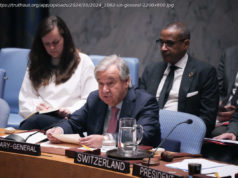Activists want the UK to commit to zero net emissions by 2025. Is that possible?
Thousands of activists have been unleashing strategic disorder in London over the past 10 days to draw attention to the accelerating climate crisis. In costume and in tents, they’ve barricaded roads and bridges at major city landmarks, with more than 1,000 peacefully submitting to arrest.
The coordinated direct actions across the city have been organized by Extinction Rebellion, a movement founded last year to demand a more aggressive climate target from the British government: net-zero greenhouse gas emissions by 2025.
With a core message that climate change is an “emergency” that threatens the survival of the human species, Extinction Rebellion is sounding a shriller alarm than past climate protests. Members are also deploying ostentatious, nonviolent tactics — such as gluing themselves to the Waterloo Bridge — at a scale that “has never been done before,” according to Alanna Byrne, a press coordinator with Extinction Rebellion.
“We know we have disrupted your lives,” the group said Wednesday in a statement. “We do not do this lightly. We only do this because this is an emergency.”
Extinction Rebellion’s urgency and energy on climate change is aligned with a wave of youth climate activism bubbling up in Europe, the United States, and beyond — including a series of student strikes, led by the riveting Greta Thunberg, a 16-year-old from Sweden.
Thunberg arrived in London on Sunday to join the Extinction Rebellion protests and deliver a fiery speech to British members of Parliament, whom she says have failed to take climate change seriously: “You don’t listen to the science because you are only interested in solutions that will enable you to carry on like before,” she chided.
If a protest is measured by how much attention and irritation it stirs up, then Extinction Rebellion has been wildly successful. London Mayor Sadiq Khan, Conservative member of Parliament Boris Johnson, and media celebrities have all called the protesters a nuisance and asked them to stop. A couple of lawmakers and the actress Emma Thompson have rallied behind them.
“I think Extinction Rebellion is extremely important,” Edward Maibach, director of the Center for Climate Change Communication at George Mason University, told Vox. “They’re showing how much they care and that they’re willing to pay the price — be arrested — because government inaction on climate change is unacceptable. I hope it catches on.”
Yet as the protesters transition this week from disrupting transit to pleading with policymakers, new questions have emerged: How quickly can the UK get to net-zero emissions? And will Extinction Rebellion make a difference in setting that target?
Extinction Rebellion began in the minds of 15 organizers in April 2018 who were part of the UK activist group RisingUp!. The premise was that a more rebellious resistance was needed against “business as usual” and that governments needed to be pressured more to cut greenhouse gas emissions to zero.
Extinction Rebellion, also known as XR, officially launched in October, a few weeks after the Intergovernmental Panel on Climate Change (IPCC) released a massive report on the impacts of global warming of 1.5 degrees Celsius. Its key message, which reverberated around the world, was that humanity still has a shot at limiting warming to 1.5°C, and thereby avoiding further catastrophe in the form of disease, famine, water scarcity, and sea-level rise. But time is running out — we may have as little as 11 years left to hit that target, and we are way off track.
The movement also burst onto the scene with the explicit support of the leftist Guardian columnist George Monbiot, who wrote on October 18 that “a people’s rebellion is the only way to fight climate breakdown.
Домой
United States
USA — Criminal Extinction Rebellion, the climate protesters disrupting London, explained






